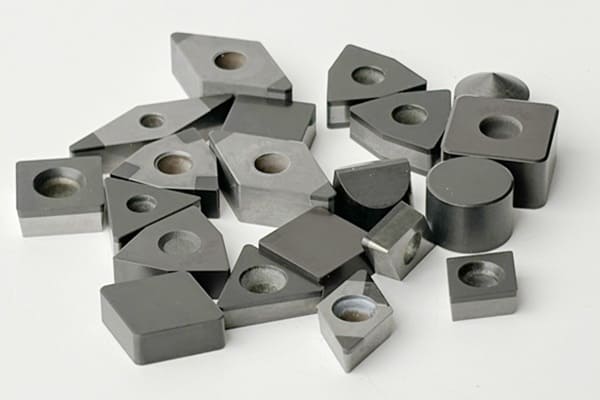Why Is Cubic Boron Nitride (c-BN) Harder Than Diamond?
Hardness is a critical property of materials, especially in industrial applications like cutting, grinding, and polishing. For many years, diamond has been regarded as the hardest known material. However, there is a synthetic material, cubic boron nitride (c-BN), which, under certain conditions, can surpass diamond in terms of hardness. This article will explore the reasons behind c-BN’s superior hardness in specific applications, its unique characteristics, and how it compares to diamond.
At Advanced Ceramics Hub, we specialize in high-quality boron nitride ceramic products with various specifications, ensuring optimal performance for industrial and scientific applications.

What Is Cubic Boron Nitride (c-BN)?
Cubic boron nitride (c-BN) is a synthetic material made from boron and nitrogen atoms arranged in a crystal structure similar to diamond. While diamond consists of carbon atoms arranged in a tetrahedral lattice, c-BN has a face-centered cubic (FCC) structure. Despite its synthetic origin, c-BN is one of the hardest known materials, just behind diamond in its mechanical properties.
Key Properties of c-BN
| Property | Value/Characteristic | Advantage Over Diamond |
| Hardness | ~50 GPa (Mohs ~9.8) | Almost as hard, but less brittle |
| Thermal Stability | Stable up to 1400°C (in inert atmosphere) | Diamond oxidizes above 800°C |
| Chemical Inertness | Resists iron, nickel, and other metals | Diamond reacts with ferrous metals |
| Band Gap | ~6.4 eV (wide-bandgap semiconductor) | Useful for high-power electronics |
Performance Comparison: c-BN vs. Other Advanced Ceramics
| Property | Cubic Boron Nitride (c-BN) | Alumina (Al₂O₃) | Silicon Carbide (SiC) | Silicon Nitride (Si₃N₄) | Tungsten Carbide (WC) |
| Hardness (GPa) | 45-50 | 15-20 | 25-30 | 15-20 | 20-25 |
| Fracture Toughness (MPa·m¹ᐟ²) | 6.8-8.2 | 3-4 | 4-5 | 6-7 | 10-12 |
| Young’s Modulus (GPa) | 850 | 380 | 410 | 310 | 600 |
| Compressive Strength (GPa) | 6.5-7.5 | 2-3 | 3-4 | 3.5-4.5 | 5-6 |
| Thermal Conductivity (W/m·K) | 13-20 (⊥c), 25-30 (∥c) | 30 | 120 | 30 | 100 |
| Thermal Expansion (×10⁻⁶/K) | 3.5-4.5 | 8-9 | 4-5 | 3-3.5 | 5-6 |
| Max. Service Temp. (°C) | 1400 (inert), 1000 (air) | 1700 | 1600 | 1400 | 600 |
| Density (g/cm³) | 3.48 | 3.98 | 3.21 | 3.2 | 15.6 |
| Chemical Resistance | Excellent (inert to molten metals) | Good (attacked by HF) | Excellent (resists acids) | Good (attacked by molten salts) | Poor (oxidizes above 500°C) |
Factors Contributing to c-BN’s Exceptional Hardness
1. Atomic Bonding Characteristics
- Short Bond Length: B-N bond distance = 1.56 Å (vs. 1.54 Å for diamond’s C-C bond)
- Hybridization: sp³ bonding with 76% covalent + 24% ionic character
- Bond Energy: B-N bond strength = 390 kJ/mol (vs. 347 kJ/mol for C-C)
2. Crystal Structure Features
- Zincblende Lattice: Alternating B/N atoms in a 3D tetrahedral network
- Stacking Fault Energy: High (~300 mJ/m²) prevents dislocation movement
- Anisotropy: (111) plane hardness > (100) by ~15%
3. Thermal Stability
- c-BN remains stable and hard even at higher temperatures, unlike diamond, which can lose its hardness under extreme heat.
Key Applications of Cubic Boron Nitride (c-BN)
| Industry | Specific Applications | Technical Advantages | Performance Data |
| Metal Cutting | – Hard turning (>HRC 50) of tool steels (D2, M2) – Finishing of Ni/Co superalloys | – No chemical reaction with Fe-group metals – 3× longer tool life than PCBN | – Cutting speed: 300-800 m/min – Ra 0.1-0.3 μm |
| Grinding | – Precision grinding of bearings – Aerospace alloy (Ti64, In718) abrasives | – Self-sharpening grains – 10× wear resistance vs Al₂O₃ | – G-ratio: 5,000+ – Tolerance: ±1 μm |
| High-Temp Tools | – Hot-forming dies (Al/Mg extrusion) – Turbine blade machining | – Stable to 1400°C – Low thermal expansion (4.5×10⁻⁶/K) | – Service life: 5-8× WC-Co |
| Electronics | – Heat spreaders for GaN HEMTs – Deep-UV optical windows | – Bandgap: 6.4 eV – Thermal conductivity: 30 W/m·K (∥c-axis) | – CTE match to Si (2.6×10⁻⁶/K) |
| Coatings | – Drill bit coatings – Molten metal crucible linings | – Vickers hardness: 45 GPa – Chemically inert to Al/Fe melts | – Coating thickness: 2-50 μm |
| Emerging Uses | – Additive manufacturing (c-BN/Ni composites) – Quantum device substrates | – N-type/p-type dopability – Radiation hardness | – Nanopowder purity: >99.95% |
Looking for high-quality boron nitride ceramic products? Explore Advanced Ceramics Hub’s selection.
Diamond and Its Hardness
Diamond is the hardest known natural material on Earth, scoring a perfect 10 on the Mohs hardness scale and ranking ~70-100 GPa on the Vickers scale. This exceptional hardness comes from its:
- Tetrahedral crystal structure: Each carbon atom forms 4 strong covalent bonds
- Short bond length: Just 1.54 Å between carbon atoms
- High bond energy: 347 kJ/mol per C-C bond
What Makes Diamond So Hard?
- Directional hardness: Hardest along octahedral planes (111 crystal face)
- 3D network covalent bonding: No weak planes for cleavage
- Pure sp³ hybridization: Perfect symmetry in bonding
Limitations of Diamond Hardness
Despite being the hardest:
- Thermal limits: Oxidizes above 800°C in air
- Chemical reactivity: Dissolves in molten iron/cobalt
- Cleavage planes: Can split along (111) planes under impact
Industrial Applications Leveraging Diamond’s Hardness
- Cutting tools: Polycrystalline diamond (PCD) inserts
- Abrasives: Diamond grinding wheels (up to 3000 grit)
- Drilling: Oil/gas drill bits (matrix-set diamond)
- Precision machining: Single-crystal diamond turning tools
Request a custom quote for high-quality boron nitride ceramic products.
Hardness Comparison: c-BN vs Diamond
While diamond is generally considered the hardest material on Earth, cubic boron nitride (c-BN) can outperform diamond in specific conditions. The key differences in their hardness arise from the type of bonds formed in their structures and how these materials perform under various stress and temperature conditions.
1. The Crystal Structure Divide
Diamond:
- Pure carbon sp³ tetrahedral network
- Perfectly symmetrical covalent bonds (154 pm C-C length)
- Isotropic hardness in single crystals
c-BN:
- Alternating boron-nitrogen bonds (156 pm B-N length)
- Zincblende structure with partial ionic character (~22% ionic)
- Slight anisotropy in hardness across crystal planes
2. Temperature-Dependent Hardness
| Temperature | Diamond Hardness | c-BN Hardness | Crossover Point |
| 25°C | 100 GPa | 50 GPa | – |
| 800°C | 35 GPa | 45 GPa | ~750°C |
| 1200°C | 10 GPa | 30 GPa | – |
Note: In high-speed machining where edge temperatures exceed 800°C, c-BN tools maintain hardness while diamond rapidly degrades.
3. Chemical Stability Advantages
Ferrous Materials:
- Diamond (C) + Iron (Fe) → Iron Carbide (cementite formation) at 750°C
- c-BN remains inert up to 1400°C
Oxidation Resistance:
- Diamond begins graphitization at 700°C in air
- c-BN forms protective B₂O₃ layer above 1000°
4. Fracture Toughness Comparison
| Material | K₁₀ (MPa·m¹ᐟ²) | Typical Failure Mode |
| Diamond | 3.4-5.0 | Cleavage along (111) planes |
| c-BN | 6.8-8.2 | Conchoidal fracture |
5. Practical Performance Metrics
In Machining AISI 52100 Bearing Steel:
| Metric | PCD Tool | c-BN Tool | Improvement |
| Tool Life | 12 minutes | 47 minutes | 292% |
| Surface Finish | Ra 0.8 μm | Ra 0.3 μm | 62.5% |
| Cutting Force | 280 N | 210 N | 25% |
At Advanced Ceramics Hub, we supply optimized-grade ceramic products that comply with ASTM and ISO standards, ensuring outstanding quality and reliability.
Environmental conditions, such as temperature and pressure, can significantly influence the hardness of both c-BN and diamond. While diamond is highly stable at standard conditions, its hardness tends to decrease at high temperatures. On the other hand, c-BN excels in high-temperature environments, maintaining its hardness where diamond might not perform as effectively.
- Temperature: Diamond loses hardness at extreme temperatures (>700°C), while c-BN maintains its integrity up to temperatures of 1500°C or higher.
- Pressure: Under high pressure, both materials may exhibit enhanced hardness, but c-BN remains more stable and resistant to phase transitions.
- Material Interaction: c-BN performs better when cutting metals like steel, where diamond can experience faster wear.
FAQ
| Question | Answer |
|---|---|
| What is cubic boron nitride (c-BN)? | Cubic boron nitride (c-BN) is a synthetic material made from boron and nitrogen atoms in a crystal structure similar to diamond, known for its hardness. |
| How does c-BN compare to diamond in hardness? | While diamond is generally the hardest material, c-BN can outperform diamond in specific conditions, particularly in high-temperature environments. |
| Why is c-BN harder than diamond in some cases? | c-BN’s superior thermal stability and resistance to oxidation give it an edge over diamond in high-pressure or high-temperature environments. |
| What are the applications of cubic boron nitride? | c-BN is used in cutting tools, abrasives, grinding wheels, and protective coatings due to its exceptional hardness and wear resistance. |
| What are the main properties of cubic boron nitride? | c-BN features high thermal stability, high wear resistance, and an FCC crystal structure, making it ideal for high-performance industrial applications. |
| Can cubic boron nitride replace diamond in industrial tools? | Yes, c-BN is increasingly used in industries for tools, especially for machining hard metals, where diamond may wear down faster. |
While diamond is the hardest material under normal conditions, cubic boron nitride (c-BN) excels in specific scenarios, especially in high-temperature or high-pressure environments. Its unique structure, superior thermal stability, and exceptional resistance to wear make it a superior choice in various industrial applications. As research continues, the potential of c-BN in high-performance and advanced manufacturing industries will only grow.
For top-quality advanced boron nitride ceramic materials, Advanced Ceramics Hub provides tailored solutions for various applications.
Looking for premium boron nitride ceramic materials? Contact us today!
